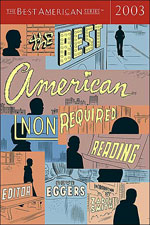[Transcribed discussion of “Hair Types,” a comic by Olivier Schrauwen, published in Mome.
In this sequence, the artist depicts a workroom of men drawing. They are dressed in suits and a couple wear mighty beards. It seems to be taking place circa 1900. One man draws a diagram of hair types—Docile, Rigid, Frivolous, Intrusive, Wild, Crazy—and the kind of head that each hair type sits on. Another man in the room—a man with blond, spiky hair—sees the diagram. He and the fellow who drew it get into an argument about what kind of hair type the blond man has. Others join in the debate. Soon everyone in the room is drawing hair diagrams and interpreting them. The supervisor hears the commotion and barges in. He wants to know what’s going on. He looks at the hair drawings. The supervisor is pleased with the industriousness of his drawing-men.
The students were asked if they followed the story.]
Will: It made sense to me. They’re all workers working and then the supervisor comes in.
Sophia: I think it’s not supposed to make that much sense but you can make a lot of sense out of it. [Laughs] Does that make sense?
Molly: I thought the drawings paired with the words this way were really funny, even if I didn’t understand all of it.
Sophia: Yeah, I thought the drawings were hilarious.
[The students were asked what the men were doing.]
Bora: I thought it was kind of a think-tank. I don’t know why. Maybe all the high-backed chairs? All the stern faces?
Roxie: I took it differently. I thought they just had some super normal desk job and they were messing around. I thought they were just goofing around. Bored at the office. And I think the drawing at the end is a drawing of their ideal women, how they each want their woman’s hair to look. I think this piece really stands out. I think it’s well drawn and it’s mysterious enough that you want to keep reading.
[The final drawing in the sequence is a diagram of women. Each one wears a different example of the hair types—Docile, Rigid, Frivolous, and so on.
Throughout the piece, the drawings are done with a charcoal-like pencil. The lines are sometimes smudged artfully.]
Sophia: I liked the blur effect. It made it like watching TV. But at the same time the facial hair wasn’t modern so it looks like it was some time way before TV.
Bora: The whole piece is just a little odd. In a good way, I think. And it’s an unusual length.
[The students were asked if someone reading the anthology would take the time to read the piece, even though it’s strange.]
Charley: I think there are a lot of good things to catch in this story, so yes, definitely. I mean, there are all these corresponding types of hair throughout the story to pay attention to. And there are words I didn’t know like “toxicomany.” There are lots of levels. It’s a puzzling piece but it’s really good.
Roxie: I think even if you were just flipping through the book, the drawings would be enough to stop you and make you want to read it.
Adrianne: I like that the piece has so few words. It’s a break from words.
[The very last frame of the piece is dots. It’s a frame of oversized pixels. The students were asked why the artist ended with this drawing.]
Yael: Maybe it’s hair follicles. It looks like a shaved head up close. A shaved head has little dots if you look closely.
Will: The artist does this elsewhere. It seems like he’s trying to create a different mood whenever he uses dots in a frame’s background. So I think he’s setting the mood he wants to end on.
Roxie: Or maybe he just had an extra panel and had to fill it.
Molly: Or maybe it’s like static on a television.
Subscribe to:
Post Comments (Atom)









No comments:
Post a Comment